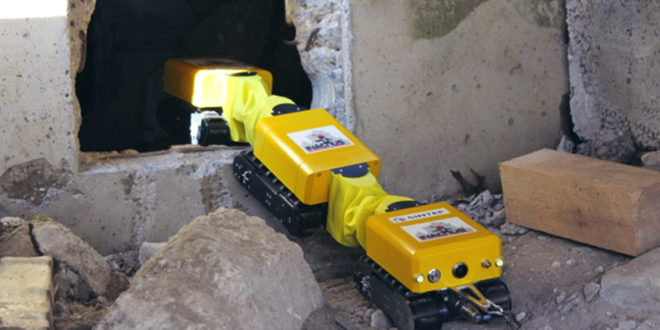© INACHUS Project, 2014-2018
Emergency events in urban areas, either due to natural disasters (earthquake, hurricane, flood) or acts of war or terrorism, can lead to massive destruction, damaging infrastructure and causing injury and loss of life. In such situations, the work of urban search-and-rescue (USAR) teams is vital to ensure that people are evacuated safely and that trapped victims are located and rescued as quickly as possible. Recent technological advances have enormous potential to make the work of rescue teams and first responders (FR) more effective and safer. However, this potential has yet to be harnessed in an integrated way.
The EU-funded INACHUS project brought together a wide range of partners, including FRs and USAR teams, to develop an integrated platform incorporating a number of new technologies, to improve overall situational awareness and the ability to rapidly detect and locate trapped victims.
INACHUS is very unique in that it directly addresses the needs of USAR teams, says the projects technical coordinator, Evangelos Sdongos. With their input, we have developed a set of novel tools that will help move urban rescue work significantly forward technologically. In particular, the project worked closely with the International Search and Rescue Advisory Group (INSARAG) which provided valuable feedback.
Next-generation tools
Generally speaking, the area of search and rescue has been slow to adopt new technologies, relying very much on mechanical equipment to do their work. INACHUS paved the way for the adoption of novel, next-generation tools both on the ground and in the air.
At ground level, a miniaturised robotic prototype incorporating a number of novel technologies and sensors was trialled in four large-scale pilots. The remotely controlled robot was specifically designed to help rescue teams to find and communicate with victims trapped under collapsed buildings.
It incorporates various sensors which can detect the location and direction of even very small movements (such as breathing), can detect dangerous gases, a mobile phone detector, an infrared camera and a two-way communication system which allows victims and rescue teams to communicate with each other. The position of the robot is automatically tracked and information fed back into an integrated communication platform so that rescue teams can pinpoint exactly where the survivors are trapped.
In addition, the contribution of unmanned aerial vehicles (UAV) or drones was developed and recognised as a valuable tool to complement the information received on the ground. A range of UAVs gathered visual, thermal and laser-based data which was fed into the central platform to provide enhanced information to the rescuers concerning debris, fissures, dangerous locations, etc.
This information supported data from a miniaturised ground-penetration radar system and an array of seismic/vibration sensors. In addition, 3D-mapping tools made a significant contribution to the ability of FRs to quickly establish an accurate picture of risks and better manage resources, explains Sdongos. The aim is to integrate the use of these new technologies into USAR so as to speed up rescue operations and save more lives.
Interoperability
To ensure the INACHUS solutions are adopted as widely as possible, the project initiated a CEN/CENELEC workshop on the technical and procedural interoperability of USAR robotic platforms in order to work towards the development of a European standard in this field. This will significantly facilitate the work of international teams working together in disaster situations. As a result, the team hopes a generic platform can be designed and built for any possible search-and-rescue scenario on the ground. A common standard will also be useful for those responsible for designing and manufacturing USAR tools, equipment and sensors.
The INACHUS project has made significant progress towards integrating advanced technologies into the work of USAR teams on the ground. This work is being further developed within two new EU-funded projects, INGENIOUS and CURSOR. Moreover, tools developed by INACHUS are now being trialled and further developed by rescue teams in France, Italy and Greece in an ongoing validation and adoption process.
 Unmanned Aerial Vehicle The latest drone news
Unmanned Aerial Vehicle The latest drone news




